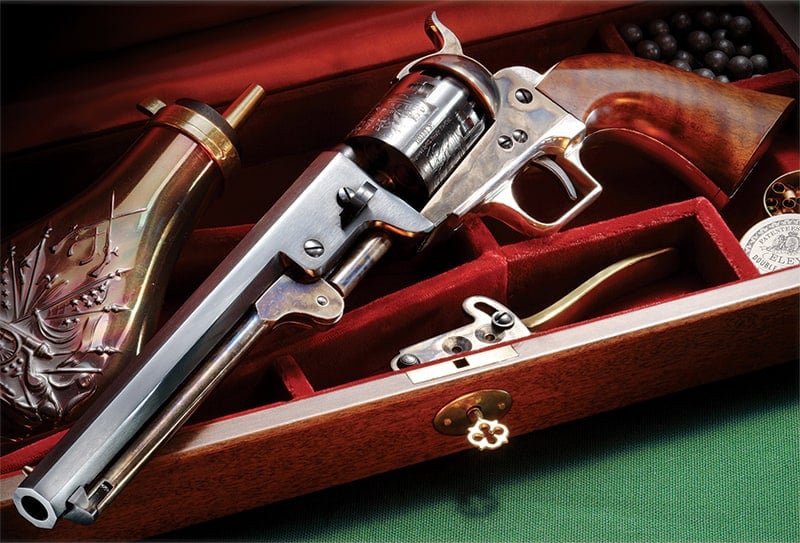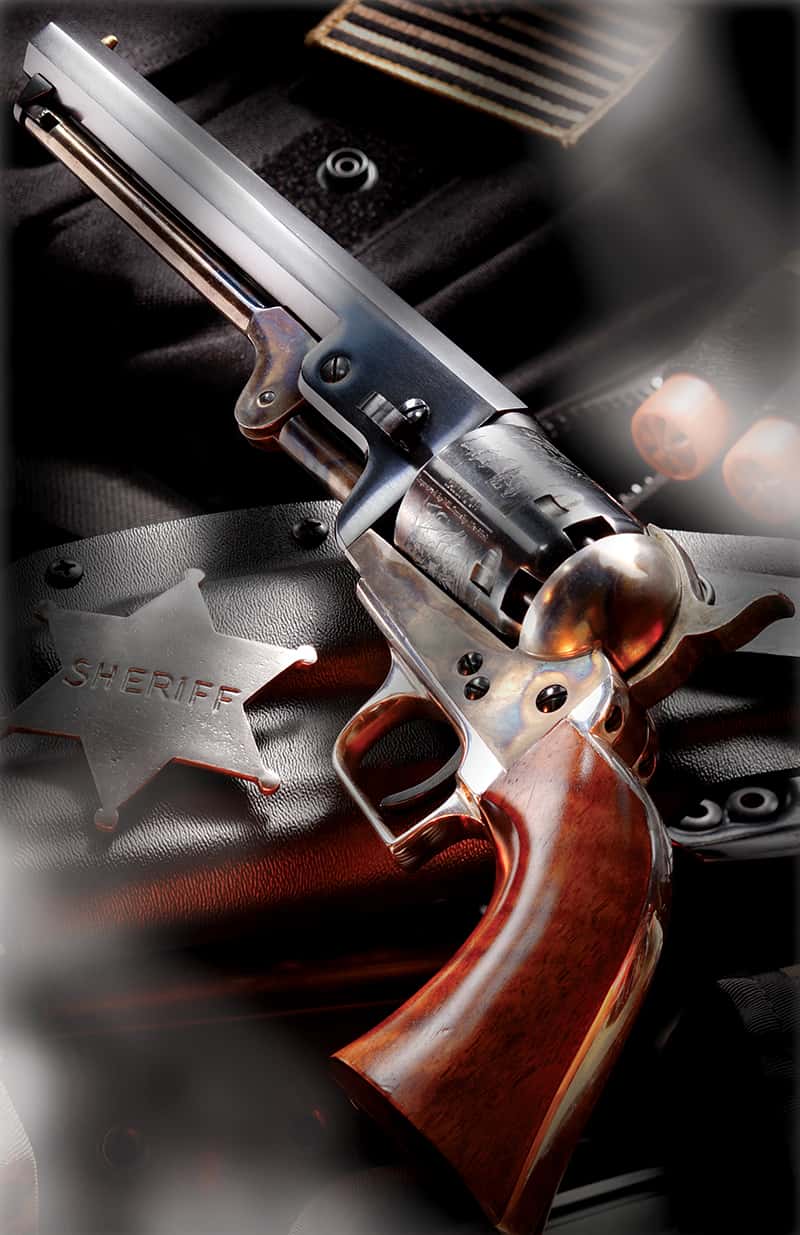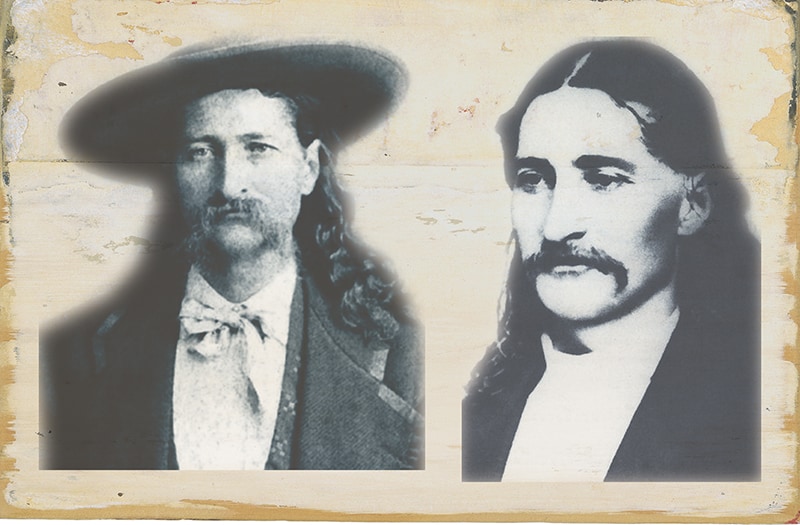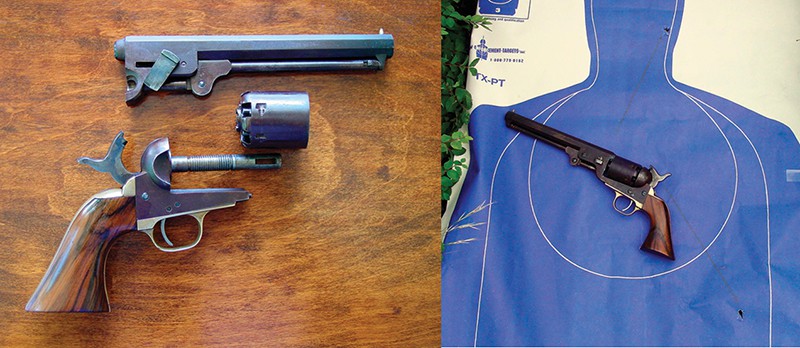Wild Bill's Best Bud
The Classic Colt 1851 Navy
In 1851, just nine years after the Hayes Big Fight, Samuel Colt showcased the Navy Colt at the Crystal Palace Exposition in London. Revolver evolution had proceeded at break-neck speed and the 1851 model represented a quantum leap from the first Patersons Captain Jack Hayes and his small band of Texas Rangers had used to route a large force of Comanche in the new Republic of Texas. The new model had far fewer action parts and had arrived at the stage of human engineering that would take the Single Action into the cartridge era and serve as the bellwether for handguns of the classic form for the next century and a half and beyond.
The revolver was a complete novelty on that side of the Atlantic and the British were far behind Colt in the field of mass-production. Making use of talents developed when he was hawking snake oil, Colt convinced the British bureaucracy they would never liberate the Cape Colony from the Xhosa until they adopted this revolver as a service arm. The pitch worked like a charm and Colt’s London Company prospered from 1853-59. In those years, the Sun never set on Samuel Colt’s fledgling Empire.
At that time, the recently annexed State of Texas was a virtual Eden where every prospect pleased and only man was vile. It was a vast region sparsely populated by anglo settlers, erstwhile citizens of Mexico and a scattering of native tribes none of which populations could get along with any of the others. Travelers remarked that every man and boy in the settle area seemed to possess at least one Navy Colt.
In later years, the .36 bore Navy shared its popularity with the large caliber Army Revolver and other designs that emerged during the Civil War. Arguably however, nothing in the percussion era matched the old model of 1851 in its handling dynamic or supplanted it in usable accuracy. Hickok we know, came out of the War of Succession with the Navy and stayed with it well into the cartridge era. Legend has it he became miffed at one Dave Tutt during a card game and performed a wonderful feat that launched his own reputation as a pistol fighter and assured the immortality of the otherwise obscure Mr. Tutt. More about that later.
As I’ve remarked before, the percussion revolvers, once experienced, create something of a life-long addiction. The passage of time diminishes the memory of the nasty cleaning jobs and broken trigger/bolt springs — overshadowing them with visions of Aura-Lee, Green growing lilacs, vast plains and buffalo clover. In the present case, I developed a minor obsession with the Dave Tutt situation and a growing desire to repeat it.
Shooting Tutt
I start out with a Navy Model that seems to have been sent stateside with a batch intended for the Colt Black Powder series of the late 70s. It arrived very well fitted and finished polished but in the white and absent the front sight bead. Proof marks and maker’s name are nowhere to be found and the only marking is the number “272” out of sight on the major sub-assemblies. I finished it in an even, deep plumb brown as bottled by Birchwood-Casey. Johnny Bates, a profoundly-learned black powder and history buff supplied a front bead of the correct height for 25-yard shooting.
Walking it through its paces, I found it sufficiently-accurate to nail 2/3 size rabbit targets when fired two-handed back to 20 yards. I managed to keep all my shots in the five ring of a TXTP silhouette target back to 40 paces firing one handed and landed two consecutive shots low in the stomach when I had reached 50 yards.
The sighting arrangements is crude – a front cone and a notch at the top of the hammer visible only with the hammer at full stand. It’s remarkable what you can do with a set of crude sights when the light is right and the Navy does at least, have a nice, long sight radius. This example hangs steady on target throughout a rather creeping six pound trigger release. I soon pronounced myself ready to rekill Dave Tutt, or as ready as I was every likely to get.
It’s said Mr. Hickok and Mr. Tutt agreed to a classic walk-down on the main street of Springfield, Missouri, with Tutt to start at one end and Wild Bill at the other — honor to be vindicated. As legend has it, as soon as Tutt hit the street, James Butler raised his revolver, took a two handed braced hold of some sort and croaked out his rival with a single shot.
Distance of the shot is reported to be from 70 to 80 yards, winning great respect for Mr. Hickock among the citizenry. I would endeavor to do the same as Wild Bill, sans the dead body.
75 Paces
We set up a TXTP target at 75 paces and I let go my first shot standing with two hands. I missed. The next shot was from 30 yard to establish windage. Shots three and four would have either made moribund Mr. Tutt or caused him to fall over form sheer surprise, as one struck the head portion of the target and the other plowed into the short-ribs.
Shot number five was another miss, but by this time it appears the bolt arm of the two-fingered spring had expired and the bolt did not engage. All in all, it appears my shooting might have more closely resembled that of the deceased Tutt than JBH’s. But even I was able to prove the dangerous nature of the Navy at a reasonable long range.
The Navy Colt was state of the art from Balaclava to Bell County, Texas. It supplied the basic platform for the first Colt cartridge revolvers of 1871-72, and then the famous Single Action Army that remains a standard to the present day. We had fun shooting it and getting to know it.
Heinie Springs
Some shooters are able to use the Navy replicas with nary a thought to the fragile nature of the double leaf spring. I, on the other hand, can break those same springs in much the same manner that Uri Geller used to bend spoons.
The Brownells Catalog contains a number of after-market parts for Colts and Ubertis, and one such item is a replacement trigger-bolt set-up made from durable, round, mouse-trap-like stock. I ordered one of these and found it a drop-in fit in this revolver. The trigger pull was not altered and function is indistinguishable from the original setup.

Get More Revolver Content Every Week!
Sign up for the Wheelgun Wednesday newsletter here:









